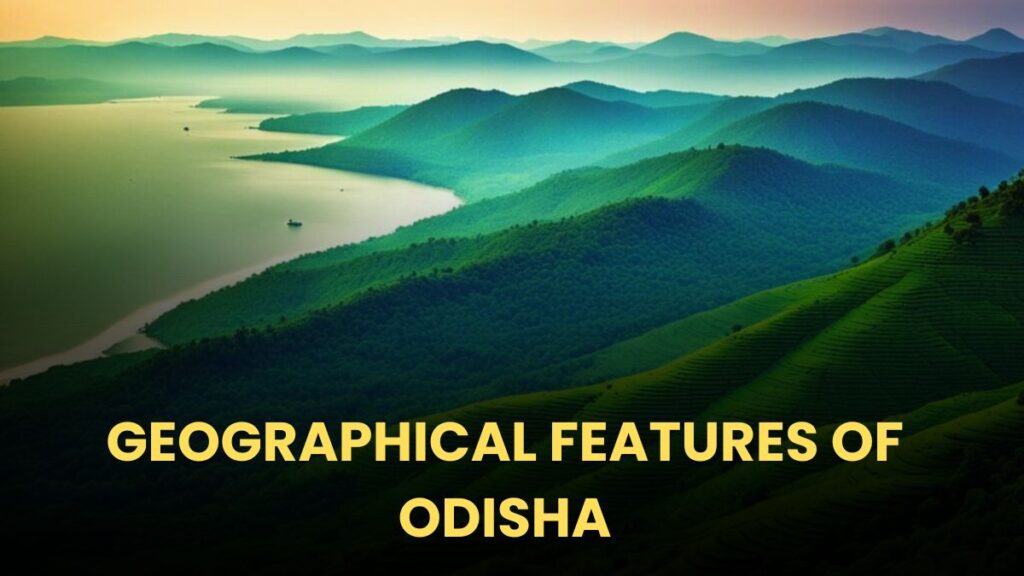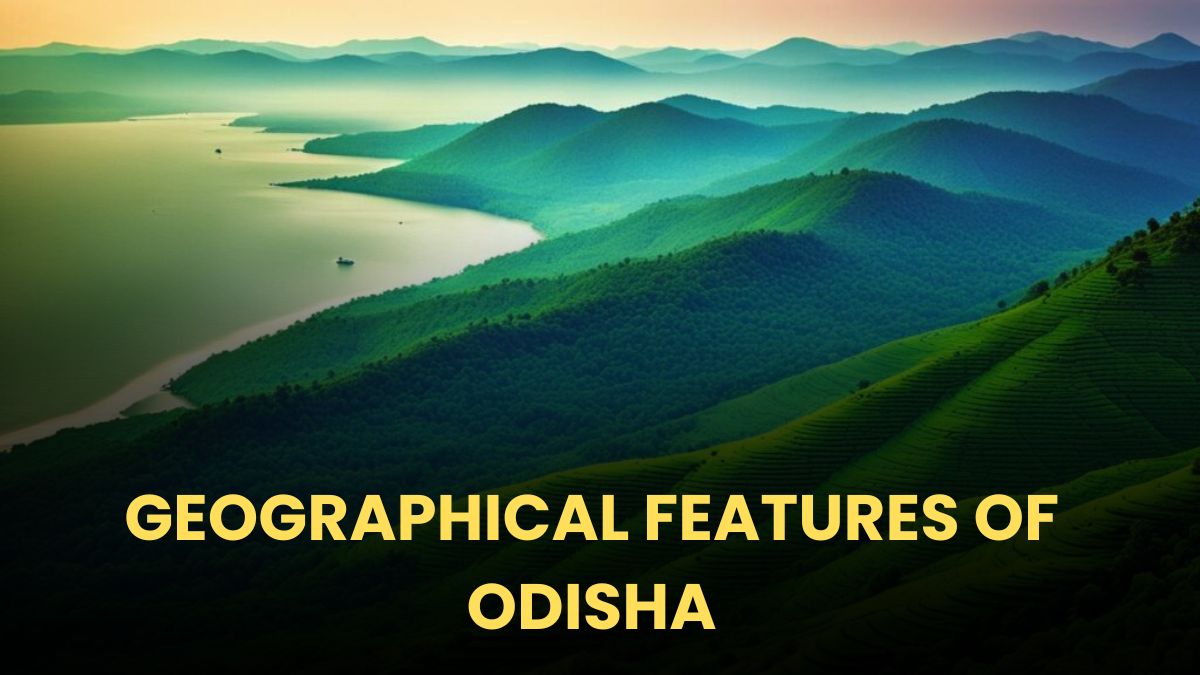Odisha sits on the Eastern coast of India, bordered by the Bay of Bengal to the East and South-East. Today, Odisha is a top spot for tourists. It’s the ninth biggest state by area and the eleventh by population.
Location and Extent of Odisha
- Odisha spans from 17°49’N to 22°34’N latitudes and 81°27’E to 87°29’E longitudes. Its capital, Bhubaneshwar, is known as the Cathedral city or Temple city.
- It covers an area of 1,55,707 sq km, making up about 4.73% of India’s total land area.
- Odisha boasts a 450 km coastline from Ichchapuram in the South to Subarnarekha in the North-East.
- It stretches from Brahmagiri on the Chilika lake in the South-West to Chandabali in the North-East.
- It’s the ninth largest state in India by area and the eleventh by population.
Boundaries of Odisha
Odisha is one of India’s 29 states, located on the Eastern coast.
It’s bordered by Jharkhand to the North, West Bengal to the North-East, and the Bay of Bengal to the East.
Andhra Pradesh lies to the South, and Chhattisgarh to the West and North-West.
Physiographic Region of Odisha
Odisha is divided into five major regions based on their characteristics. These regions are:
1. The Odisha Coastal Plains in the East
2. The Middle Mountainous and Highlands Region
3. The Central Plateaus
4. The Western Rolling Uplands
5. The River Valleys and Flood Plains
READ MORE – HERE
1. The Odisha Coastal Plains in the East
- These plains are young and belong to the Post-Tertiary period. They stretch along India’s Eastern coast from the Subarnarekha to the Rushikulya river.
- The plains are 75 m wide and are very fertile, earning them the nickname Rice Bowl of Odisha. They are narrow in the North and South, but widest in the middle.
- This area is known as the Hexadeltaic region or the Gift of Six Rivers. The six rivers are the Subarnarekha, the Budhabalanga, the Baitarani, the Brahmani, the Mahanadi, and the Rushikulya.
The coastal plains are split into three parts:
Northern Coastal Plains/Balasore Plains
- This area is often hit by drought. It includes the flood plains and deltas of several rivers.
- Middle Coastal Plains/Cuttack-Puri Coastal Plain
- This area is between the Northern and Southern Plains. It includes the deltas of several rivers, including the Mahanadi.
Southern Coastal Plains/Rushikulya Plains
- It is made up of the Rushikulya river’s fluvial part. It also includes the Laccustrine plain of Chilika lake and smaller deltas of Rushikulya river. The Southern plains are split into three zones along the shoreline:
- The Salt Tract is a narrow belt near the coast, about 4.8 to 9.6 km wide. It’s covered with tidal forests and is full of salt. This area is not good for farming because of its brackish streams.
- The Arable Tract is known as the rice country, in the middle of the plains. It’s the richest area for farming in the state. This part also has Levees, which help prevent river overflow but can flood a lot during high tides.
- The Sub-montane Tract is to the West of the plains. It’s where the arable tract meets the Eastern Ghats. This area has red soil and is prone to soil erosion. It also has natural vegetation from thorns to sal forests.
2. The Middle Mountainous and Highlands Region
- This region covers most of Odisha, with elevations from 610 to 1068 m above sea level. It’s part of Peninsular India and has hills and mountains of the Eastern Ghats. The region has many watersheds and rivers.
- The mountains rise steeply in the East and slope gently to the West. The Eastern Ghats are cut by broad and narrow valleys and flood plains. Major rivers like the Baitarani and Mahanadi have carved deep valleys here.
- The middle mountainous region is divided into several areas:
- Simlipal and Meghasani Mountains are volcanic and have a dome shape. They range from 600 m to 1050 m high. Simlipal is 900 m high, and Meghasani is 1147 m.
- Mankadnacha, Malayagiri, and Gandhamardan mountains lie in a North-South direction. Malayagiri is 1170 m high, Mankadnacha is 1092 m, and Gandhamardan is 1044 m. These mountains are part of the Eastern Ghats.
- Watersheds between the Brahmani and Mahanadi rivers are similar to those of the Baitarani and Brahmani interfluves. These mountains are more dissected due to the Mahanadi and Brahmani rivers.
- North-West in the Northern portion and North-North-West to South-South-West in the Southern portion.
- Common Interfluves of theMahanadi, the Rushikulya and Vamsadhara This deeply eroded watershed extends in the North-South direction. The elevation of this region
- ranges from 600 m to 1000 m. It also has many peaks which rise above 1200 m. Singaraju (above 1500 m),Mahandragiri (above 1500 m) and Devagiri (1360 m) are important peaks in the region.
- Potangi and ChandragiriMountain Ranges These mountains are the highest in Odisha. These mountains separate the Sabari basins and the Nagavali and the area is highly dissected. The average height of these mountain ranges varies from 900 m to 1350 m.
- The highest peak of Odisha Deomali peak (1672 m) lies in this range. It is in Koraput district of Odisha.Other high peaks of this range are Galikonda (1643 m), Sinkaram (1620 m) and Turiakonda (1598 m).Due to shifting cultivation, the hilltops are devoid of vegetation but the farmers practice terrace cultivation in the valleys.

3. The Central Plateaus
- These plateaus lie on the Western slopes of the Eastern Ghats which are mostly eroded in the form. The elevation of this region varies between 305 to 610 m.
- The state has two broad plateaus:
- The Panposh-Keonjhar-Pallahara Plateau of the Upper Baitarani Catchment Basin This region is surrounded by the Singhbhum and Ranchi plateaus in the North,
- the Simlipal mountain in the East and the Mankadnacha mountain in the West.
- The Baitarani is the main river which drains this region. This is the region which gets high rainfall both during monsoon and winter seasons.
- The Nabarangpur-Jayapur of the Upper Sabari Basin The Bastar mountain lies on its Western boundary whereas the Chandragiri and Potangi mountains lie on its Eastern boundary. The Sabari is the main river which drains this region along with its tributaries. This area lies under the maximum rainfall region of the state, which gets more than 178 cm of rainfall annually. Thus, fine variety of rice is cultivated
| Important Peaks | Height (in metres) |
|---|---|
| Deomali | 1672 m |
| Sinkaram | 1620 m |
| Golikonda | 1617 m |
| Yendrika | 1582 m |
| Niamgiri | 1515 m |
| Mahendragiri | 1501 m |
| Badam Pahar | 1075 m |
| Badamgarh | 1074 m |
| Kunaratir | 1064 m |
| Gandhmardan | 1060 m |
| Nrusighanath | 986 m |
| Deva Giri | 964 m |
| Balia Pahar | 950 m |
4. The Western Rolling Uplands
- These are lower in elevation than the plateaus having elevation ranging from 153 to 305 m. The Western rolling uplands are grouped into the following morphological units:
- Rajgangpur-Panposh uplands of the Koel and the Sankh rivers.
- Jharsuguda uplands of the Ib basin.
- Baragarh uplands of the Jira and Jhaun basins.
- Balangir-Titilagarh-Patnagarh uplands of Northern Tel basin.
- Bhawanipatna uplands of the Southern Tel basin.
- Malkangiri uplands of the Sabari basin.
5. The River Valleys and Flood Plains
- These valleys are shaped by the major rivers of the state. The average elevation is between 75 m and 150 m.
- The valleys are narrow and deep at the top. They get wider in the middleand widest at the bottom where they meet the plains.
Important river valleys include :
- The Mahanadi river valley
- The Brahmani river valley
- The Vamsadhara river valley
The flood plains are very fertile. Most farming happens here, thanks to the rivers.
READ HERE – Drainage System of Odisha
Lakes and Ports in Odisha
- Odisha has natural lakes like Chilika, Ansupa, Sar, Samagarh, Tampara, and Udyankhanda. There are also artificial lakes like Naraj, Jobra, Hirakud, Balimela, Rengali, Mandira, Hadagarh, and Poteru.
- There’s one natural port, Paradeep, which is the deepest in India. Chandbali and Gopalpur are medium-sized ports, and Dharma is a fishing port.
FAQs
- Odisha is located in which part of India?
Answer: Eastern Coast - The latitudinal extension of Odisha is from?
Answer: 17°49’N to 22°34’N - The longitudinal extension of Odisha is from?
Answer: 81°27’E to 87°29’E - The total geographical area of Odisha extends over?
Answer: 1,55,707 sq km - The length of the Odisha coast is about?
Answer: 450 km - Which state bounds on the South of Odisha?
Answer: Andhra Pradesh - Which state bounds Odisha on the West?
Answer: Chhattisgarh - The coastal plains of Odisha stretch on the Eastern Coast of India from which river in the North-East?
Answer: The Subarnarekha - Which area of Odisha is called the ‘Hexadeltaic region’ or the ‘Gift of Six Rivers’?
Answer: Coastal Plains - Rivers which form the Hexadeltaic region of the coastal plains of Odisha are Subarnarekha, Budhabalanga, Baitarani, Brahmani, Rushikulya, and?
Answer: Mahanadi - The Middle Coastal Plains comprise the compound deltas of the?
Answer: Baitarani, Brahmani, and Mahanadi rivers - The Mahanadi delta is in which of the following plains?
Answer: Middle - The South Coastal Plains comprises which of the following plains?
Answer: Laccustrine Plain - Which zone of the Rushikulya Plains is known as the Little Sunderbans?
Answer: Salt tract - The sub-montane tract to the West is termed as the zone of?
Answer: Transition - Which region among the physiographic regions of Odisha is marked by a number of watersheds?
Answer: Middle Mountainous and the Highlands Region - Which part of the Middle Mountainous region of Odisha is a poly-cyclic region?
Answer: Mankarnacha-Malayagiri and Gandhamardhan Mountains - Which ranges are highest in Odisha?
Answer: Potangi and Chandragiri Mountain Ranges - The highest peak of Odisha is?
Answer: Deomali peak - Deomali peak lies in which district of Odisha?
Answer: Koraput - How many central plateaus are there in Odisha?
Answer: 2 - Which among the following landforms has the least elevation?
Answer: Western rolling uplands - Which physiographic part of Odisha is most suited for agricultural activities?
Answer: Flood plains of Mahanadi

3 thoughts on “GEOGRAPHICAL FEATURES OF ODISHA”